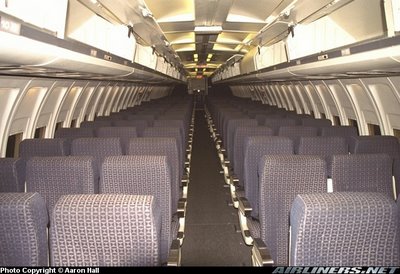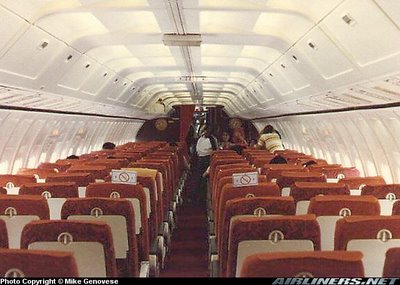Well, it's our fault for packing so damn heavily!
Here is a recent observation of mine while looking through the Airliners.net database recently...
Below are pictures of the cabin of a Delta Airlines Boeing 727, a plane that once dominated the single-aisle domestic airline market until it was supplanted by the now-popular Boeing 737, which has roughly the same configuration. The 727 last flew for Delta in the early 2000s, when the company retired its 30 year-old planes. I would have had an opportunity to fly on one of the famous 3-holers - named for the three-engined configuration - had plans for a tentative trip to Atlanta with some friends of mine in the summer of 2000 not fallen through the cracks. (Remember that one, Ben? ;-)) Anyways, that's beside the point.
Take a look at the photo below. It was taken on September 10, 2001 (in Boise, ID...it was grounded there during the 9/11 attacks of 2001 and was the first plane to take off from Boise when operations resumed after airspace was reopened...but, once again, that's beside the point). Even though this 727 is at least 30 years old in this picture, it looks pretty much the same as any first-generation Boeing 737 that still flies today. It shouldn't look too alarminging outdated...in fact, it should look familiar to anyone who flies domestic jets with some regularity today...that's because this plane has been modernized through its years flying for Delta Airlines.

The picture below is of the same model airplane (although not the same exact airplane), but taken over 20 years earlier, in June of 1979 at Boston Logan International Airport. It's at most about 10 years old at this time...so it probably appears as built. Do you note the difference between this view and the one above?

Whoa! Look at that overhead space. And what about that bright atmosphere? Yes, the 1979 plane has the same configuration. The fuselage isn't any bigger, and the lighting is typical for 727s. The difference is the large overhead compartments in the later photo, which indicates just how much space these compartments diplace on modern aircraft.
The planes are essentially identical except for the more modern yet cramping overhead compartments in the top (later) photo. Now, I haven't read up on the evolution of overhead compartments. Honestly, I cannot tell whether the 1979 plane actually has them, although I see something that somewhat resembles handles, yet they appear out of reach. Nevertheless, it appears that these compartments have grown to accomodate the larger luggage of today's burgeoning "skip-the-check-in" flying public. People don't want to check in luggage anymore, and they are still unwilling to part with their Samsonite rollaway that, even though is much larger than those sizing racks airports provide to estimate if luggage will fit onboard, must make it on the plane. I admit, I'm just as guilty as everyone else. Yet, airliner manufacturers are now boasting the extra capacity of their oversize bins, but at what cost?
I would certainly have enjoyed flying in the roomier plane of 1979 as opposed to the modernized one with "extra passenger conveniences" of this decade. This just goes to show how the attitude towards flying has changed over the years. No longer is it the cost prohibitive luxury it once was 25 years ago. Now it's simply a convenience. Who cares if you have to travel in a tube with a ceiling panel 3 inches from your head for 5 hours across the country? It beats lost luggage at your destination.
A note for plane enthusiasts...while a dying breed, the 727 is not yet dead. It is still widely used by cargo companies in a retrofitted configuration. I frequently see DHL and FedEx 727s flying into and out of Boston Logan Airport on a regular basis. The 3-holer configuration is impossible to miss.
Below are pictures of the cabin of a Delta Airlines Boeing 727, a plane that once dominated the single-aisle domestic airline market until it was supplanted by the now-popular Boeing 737, which has roughly the same configuration. The 727 last flew for Delta in the early 2000s, when the company retired its 30 year-old planes. I would have had an opportunity to fly on one of the famous 3-holers - named for the three-engined configuration - had plans for a tentative trip to Atlanta with some friends of mine in the summer of 2000 not fallen through the cracks. (Remember that one, Ben? ;-)) Anyways, that's beside the point.
Take a look at the photo below. It was taken on September 10, 2001 (in Boise, ID...it was grounded there during the 9/11 attacks of 2001 and was the first plane to take off from Boise when operations resumed after airspace was reopened...but, once again, that's beside the point). Even though this 727 is at least 30 years old in this picture, it looks pretty much the same as any first-generation Boeing 737 that still flies today. It shouldn't look too alarminging outdated...in fact, it should look familiar to anyone who flies domestic jets with some regularity today...that's because this plane has been modernized through its years flying for Delta Airlines.

The picture below is of the same model airplane (although not the same exact airplane), but taken over 20 years earlier, in June of 1979 at Boston Logan International Airport. It's at most about 10 years old at this time...so it probably appears as built. Do you note the difference between this view and the one above?

Whoa! Look at that overhead space. And what about that bright atmosphere? Yes, the 1979 plane has the same configuration. The fuselage isn't any bigger, and the lighting is typical for 727s. The difference is the large overhead compartments in the later photo, which indicates just how much space these compartments diplace on modern aircraft.
The planes are essentially identical except for the more modern yet cramping overhead compartments in the top (later) photo. Now, I haven't read up on the evolution of overhead compartments. Honestly, I cannot tell whether the 1979 plane actually has them, although I see something that somewhat resembles handles, yet they appear out of reach. Nevertheless, it appears that these compartments have grown to accomodate the larger luggage of today's burgeoning "skip-the-check-in" flying public. People don't want to check in luggage anymore, and they are still unwilling to part with their Samsonite rollaway that, even though is much larger than those sizing racks airports provide to estimate if luggage will fit onboard, must make it on the plane. I admit, I'm just as guilty as everyone else. Yet, airliner manufacturers are now boasting the extra capacity of their oversize bins, but at what cost?
I would certainly have enjoyed flying in the roomier plane of 1979 as opposed to the modernized one with "extra passenger conveniences" of this decade. This just goes to show how the attitude towards flying has changed over the years. No longer is it the cost prohibitive luxury it once was 25 years ago. Now it's simply a convenience. Who cares if you have to travel in a tube with a ceiling panel 3 inches from your head for 5 hours across the country? It beats lost luggage at your destination.
A note for plane enthusiasts...while a dying breed, the 727 is not yet dead. It is still widely used by cargo companies in a retrofitted configuration. I frequently see DHL and FedEx 727s flying into and out of Boston Logan Airport on a regular basis. The 3-holer configuration is impossible to miss.

1 Comments:
I had no idea the planes used to have that much overhead space. On almost every flight I see at least one person bang his head on the ceiling.
Post a Comment
<< Home